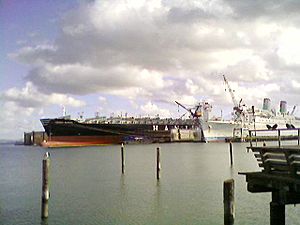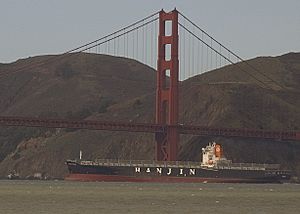Cosco Busan oil spill facts for kids
Quick facts for kids Cosco Busan oil spill |
|
|---|---|
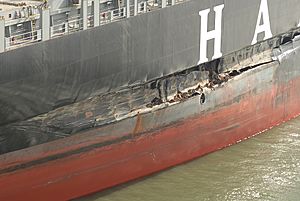
The damaged MV Cosco Busan after hitting the bridge tower fender
|
|
| Location | San Francisco Bay |
| Coordinates | 37°48′03″N 122°22′29″W / 37.80073°N 122.37486°W |
| Date | 7 November 2007 |
| Cause | |
| Cause | Cosco Busan hitting the San Francisco–Oakland Bay Bridge in thick fog. |
| Operator | Fleet Management Limited |
| Spill characteristics | |
| Volume | 53,569 US gal (202,780 L; 44,606 imp gal) |
| Area | 150 sq mi (390 km2) |
| Shoreline impacted | 26 mi (42 km) |
The Cosco Busan oil spill happened on November 7, 2007, near San Francisco and Oakland, California. A large ship called the Cosco Busan hit part of the San Francisco–Oakland Bay Bridge during thick fog. This caused about 53,569 gallons (202,780 liters) of heavy fuel oil to spill into San Francisco Bay.
Investigators found that the ship's pilot, John Cota, was not able to use the ship's radar and electronic maps correctly. This happened even though the United States Coast Guard warned him that the ship was heading towards the bridge. California Governor Arnold Schwarzenegger declared a state of emergency to help with the cleanup. This made more state help and money available to clean up the oil and fix the environmental damage.
Contents
What Caused the Oil Spill?
The National Transportation Safety Board looked into the accident. They found several reasons why the spill happened:
- The pilot's ability to think clearly was affected.
- The ship's captain and pilot did not talk enough before and during the trip.
- The captain did not watch the pilot's actions or the ship's path closely enough.
Other things that contributed to the accident included:
- The company that operated the ship, Fleet Management Ltd., did not properly train the crew. They also did not make sure the crew followed safety rules.
- The U.S. Coast Guard did not check the pilot's health records closely enough.
An article from the East Bay Express in 2009 described how different crew members made mistakes. For example, the captain gave up control to the pilot. The first mate left his post to eat breakfast. The second mate did not plan the ship's route. The third mate did not watch the ship's path using GPS.
Experts also looked at how ship controls and displays (called "Human-machine interface" or HMI) might have played a role. They suggested that problems with how these systems are designed can contribute to accidents, even if "human error" is often blamed. This is a topic that has been studied in aviation accidents for many years.
Who Was Responsible?
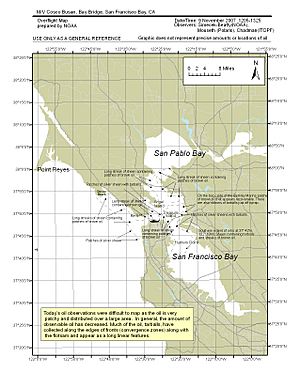
Senator Barbara Boxer and San Francisco Mayor Gavin Newsom were concerned about the Coast Guard's initial response. The Coast Guard first said only a small amount of oil had spilled, but the actual amount was much larger.
On November 30, 2007, the United States government sued the ship and its pilot.
Later, on July 23, 2008, a jury charged Fleet Management Ltd., the company that operated the Cosco Busan. They were accused of faking documents to hide information and of being careless, which helped cause the spill. The company agreed to pay $10 million in fines and money for damages. Most of this money went to a fund for victims and environmental projects in the Bay Area.
On October 23, 2008, a state report said the spill was caused by many mistakes made by the pilot, Captain John Cota. The report listed seven serious errors. These included not reading an electronic map correctly, sailing in very thick fog, and going too fast.
On March 6, 2009, Cota agreed to a deal with prosecutors. He was sentenced to 10 months in prison on July 10, 2009.
On September 19, 2011, different government groups announced a final agreement for $44.4 million. This money was for:
- $32.2 million for restoring nature (to be used for environmental projects).
- $1.25 million for state fines.
- $10.9 million for government cleanup and study costs.
Impact on the Bay Area
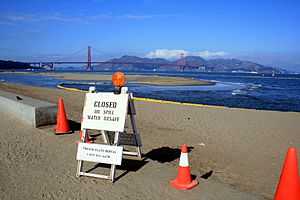
The tides in San Francisco Bay caused the oil to spread quickly. It affected a large part of the California North Coast, including the Golden Gate National Recreation Area and Ocean Beach.
More than 50 public beaches were closed. These included Crissy Field, Fort Point, Baker Beach, China Beach, and Kirby Cove. Beaches as far south as Pacifica, California, were also closed.
Richmond's shoreline and wildlife were badly affected. Beaches were closed but later reopened. However, access was still limited in December 2007. Cleanup efforts focused on the East Bay and Rodeo Beach because they were the most damaged areas.
Environmental Impact
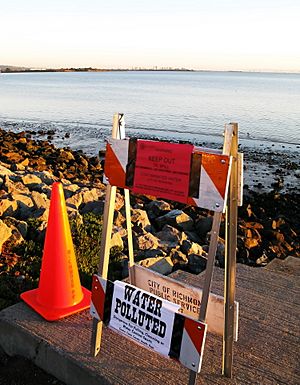
Government agencies estimated that the spill killed 6,849 birds. About 200 miles (320 km) of coastline were covered in oil. The oil also harmed the eggs laid by herring, a type of fish, in the bay. It is thought that 14 to 29% of the herring eggs in the winter of 2007-2008 were lost because of the spill.
Economic Impact
The oil spill affected several fishing businesses in the Bay Area. The crab and sport fishing seasons were delayed for several weeks. Tests found unsafe levels of oil in mussels from Rodeo Beach and the Berkeley pier.
It is estimated that people lost about 1,079,900 days of recreational activities because of the spill. This includes general beach use, fishing, and boating.
The total cost of damages was estimated at $2.1 million for the ship, $1.5 million for the bridge's fender, and over $70 million for the oil spill cleanup.
Volunteering for Cleanup
At first, officials told people not to volunteer directly with the oil. They asked volunteers to help with other tasks, like driving birds to care centers. Rules about safety training were very strict for anyone touching the oil. Later, a shorter training course was offered for volunteers who wanted to help with the cleanup.
Cleanup Timeline
In the first few days after the spill, government workers and a private company handled the cleanup. On November 11, 2007, efforts focused on checking the damage to the Cosco Busan. Oil-covered birds were taken to a care center in Fairfield. Veterinary students helped to clean and care for the birds. By November 25, some birds were healthy enough to be released back into the wild.
What Happened After?
On December 21, 2007, the Cosco Busan left San Francisco Bay. It had been renamed the Hanjin Venezia and had a new crew. It sailed to Busan, South Korea. Around the same time, repairs to the bridge fender were finished. The repairs cost $1.5 million and were completed ahead of schedule.
Images for kids


